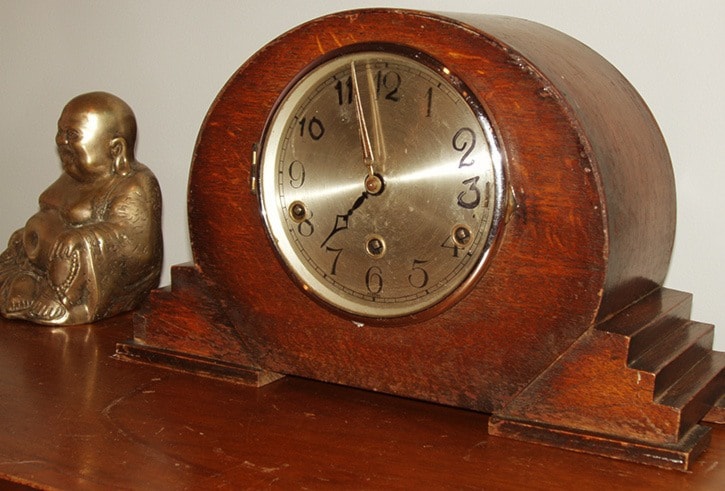My grandmother’s house was a place filled with the comforting smells of baking, of warm sunshine glowing through pleated curtains and the sound of her mantle clock chiming out the hours. Hours I spent in the company of a woman with a quiet voice, gentle hands and the patience to entertain three young girls.
My grandmother has since passed, her house and belongings sold off, but whenever my sister and I recall our visits with her we inevitably speak of the constant chiming of her mantle clock. The sound was the anthem of a time when we experienced small pools of loving calmness in an otherwise chaotic childhood.
A while back, my sister and I stopped in at a local antiques shop. I was nosing through stacks of old postcards and photographs, Cari was meandering through displays of china and kitchen items when we heard the opening bars of Westminster chimes. We looked at each other then, without a word, headed towards the sound of the steady tick-tock.
The clock wasn’t grand, vintage rather than antique. It was smaller than our grandmother’s clock, its wood veneer beginning to crack with age and neglect, but in our eyes she was beautiful. We stood momentarily transported back in time. We left the shop, postcards and teacups forgotten, a sense of longing and sadness following us outside.
Months later we were back at the antiques’ dealer. As we stepped inside, we noticed things had been rearranged. The small clock wasn’t sitting on the sideboard where we’d first seen her. We scanned the store and found a tambour mantle clock, one with the graceful camel back curve that most people think of as the typical mantle clock, but it wasn’t the one we’d fallen in love with. The one we had come for was Art Deco in its design and more compact and sturdy in appearance. We looked everywhere but she wasn’t there.
I decided to take one more look through the labyrinth of furniture. In the far back corner of the store I passed a glass-fronted bookcase when I happened to glance down at the bottom shelf and there she was.
Back home, we placed the clock on an old dresser and started the pendulum. The clock worked for only a few seconds then stopped dead. We started the pendulum again with the same results. After several unsuccessful tries a dreadful feeling that we had just bought a broken clock sunk in. The clock had been working the first time we had seen her but maybe something had happened to her since our last visit and that’s why she’d been hidden in the bottom of the bookcase.
Not one to give up easily, I booted up the computer and started to research mantle clocks. The more I read the more I realized these clocks were not just works of fine craftsmanship but more like living breathing things requiring love and attention to get them working and to keep them, keeping time.
The first requirement of any pendulum clock is to put the clock into beat. The clock should have an even tick-tock sound like the beat of a heart. Too fast and the clock won’t keep accurate time, too slow and it will stop completely after a few seconds. To put a clock into beat the clock must be absolutely level and sitting on a stable foundation because even an accidental bump can put it out of beat.
Pendulum clocks are only happy in the Now. Not even for a moment can you force it to go back in time; turning the hands backwards will break the gears. And it can’t be rushed into the future. If you spin the hands quickly without allowing it to chime each quarter hour you will throw off the chiming sequence and even risk damaging the escapement.
It took me a week to get the clock to run and chime the correct hour and quarter hours. During my learning curve, I couldn’t help notice the parallels between how to keep a pendulum clock running in perfect time and how my life could benefit from the same attention.
Mine is a 30 hour clock which means, for optimum working, it needs to be wound every day. Each evening as I attend to the needs of my clock, it draws me into reflecting how my day was. Did I go through the day feeling balanced or off kilter? Did I allow myself to become rundown or was I wound too tightly? Did I need to stop my headlong rush into the future or had I been dwelling too much in the past? Did I need to stop the pendulum, step out of the flow of time for a while and just take a break?
Nowadays, more and more people don’t even own watches much less mantle clocks, as they can check the time on their cell phones, without the hassle or the bother of maintaining an old fashioned timepiece.
In the near future will anyone care for these timepieces that require such constant attention or will they be relegated to the junk heap like so many gramophones and manual typewriters?
I hope not, for I believe that in our disposable convenience obsessed society, we need to honour the craftsmanship, skill and artistry that these antique timepieces embody. And if nothing else, caring for one of these clocks forces you to contemplate the nature of time and the value of slowing down. And perhaps inspire you to tune into the beat of your own heart and the music that your soul wishes to chime out into the world.
Written by Lora Deeprose
Special to the Arrow Lakes News
